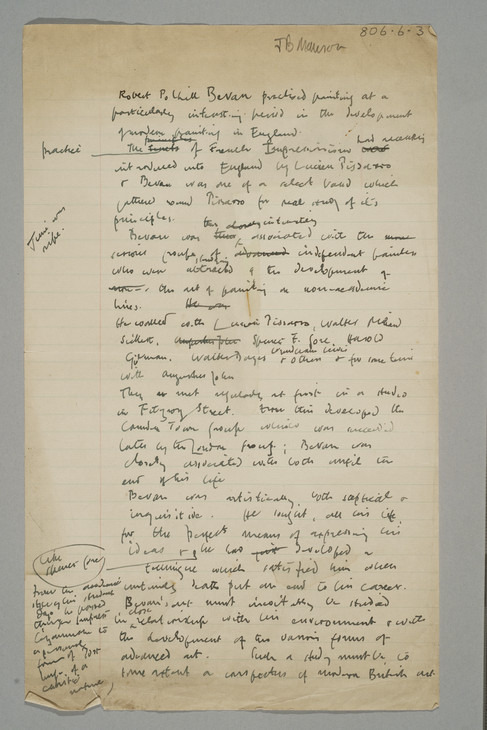James Bolivar Manson Draft Tribute to Robert Bevan c.1925
Robert Bevan died of cancer on 8 July 1925. As well as Manson, Charles Ginner and John Nash, who had been fellow members of Bevan’s Cumberland Market Group, also wrote tributes to the artist, although Nash’s was the only one published in the memorial exhibition catalogue in 1926.
Bevan’s wife Stanislawa de Karlowska had asked Walter Sickert to write the preface for the catalogue but he responded saying that Bevan ‘should be written about, I think, by someone who shared his view [on art] rather than mine’, but ‘That it grieves me to refuse you, I am sure that you & your children will easily believe’ (TGA 9210/1/4).
Manson’s tribute betrays his close ties with Lucien Pissarro and their form of impressionism, implying that Bevan had a closer affinity with Pissarro than he probably had. Ginner’s tribute is far more extensive than Manson’s or even Nash’s published preface (TGA 9210/2/7).
Transcript
Robert Polhill Bevan practised painting at a particularly interesting period in the development of modern painting in England.
The practice of French Impressionism had [?recently] introduced into England by Lucien Pissarro & Bevan was one of a select band which gathered round Pissarro for real study of its principles.
The practice of French Impressionism had [?recently] introduced into England by Lucien Pissarro & Bevan was one of a select band which gathered round Pissarro for real study of its principles.
Time was ripe [written in the margin].
Bevan was thus intimately associated with this serious group of independent painters who were [...] attracted [?by] the development of [Illegible deletion] the act of painting on non-academic lines.
He worked with Lucien Pissarro, Walter Richard Sickert, Spencer F. Gore, Harold Gilman, Walter Bayes, Wyndham Lewis & others & for some time with Augustus John
They met regularly at first in a studio in Fitzroy Street. From this developed the Camden Town Group which was succeeded later by the London Group; Bevan was closely associated with both until the end of his life
Bevan was artistically both sceptical & inquisitive. He sought, all his life, for the perfect means of expressing his ideas & like Spencer Gore he had developed a technique which satisfied him when untimely death put an end to his career. Bevan’s art must be studied in close relationship with his environment & with the development of the various forms of advanced art. Such a study must be to some extent a compectus of modern British art
He worked with Lucien Pissarro, Walter Richard Sickert, Spencer F. Gore, Harold Gilman, Walter Bayes, Wyndham Lewis & others & for some time with Augustus John
They met regularly at first in a studio in Fitzroy Street. From this developed the Camden Town Group which was succeeded later by the London Group; Bevan was closely associated with both until the end of his life
Bevan was artistically both sceptical & inquisitive. He sought, all his life, for the perfect means of expressing his ideas & like Spencer Gore he had developed a technique which satisfied him when untimely death put an end to his career. Bevan’s art must be studied in close relationship with his environment & with the development of the various forms of advanced art. Such a study must be to some extent a compectus of modern British art
from the academic struggling student days he passed through Impres-Cézannism to a [?pissarro form] of [?lost ...] of a [...] nature [written in the margin]
How to cite
James Bolivar Manson, Draft Tribute to Robert Bevan, c.1925, in Helena Bonett, Ysanne Holt, Jennifer Mundy (eds.), The Camden Town Group in Context, Tate Research Publication, May 2012, https://www

